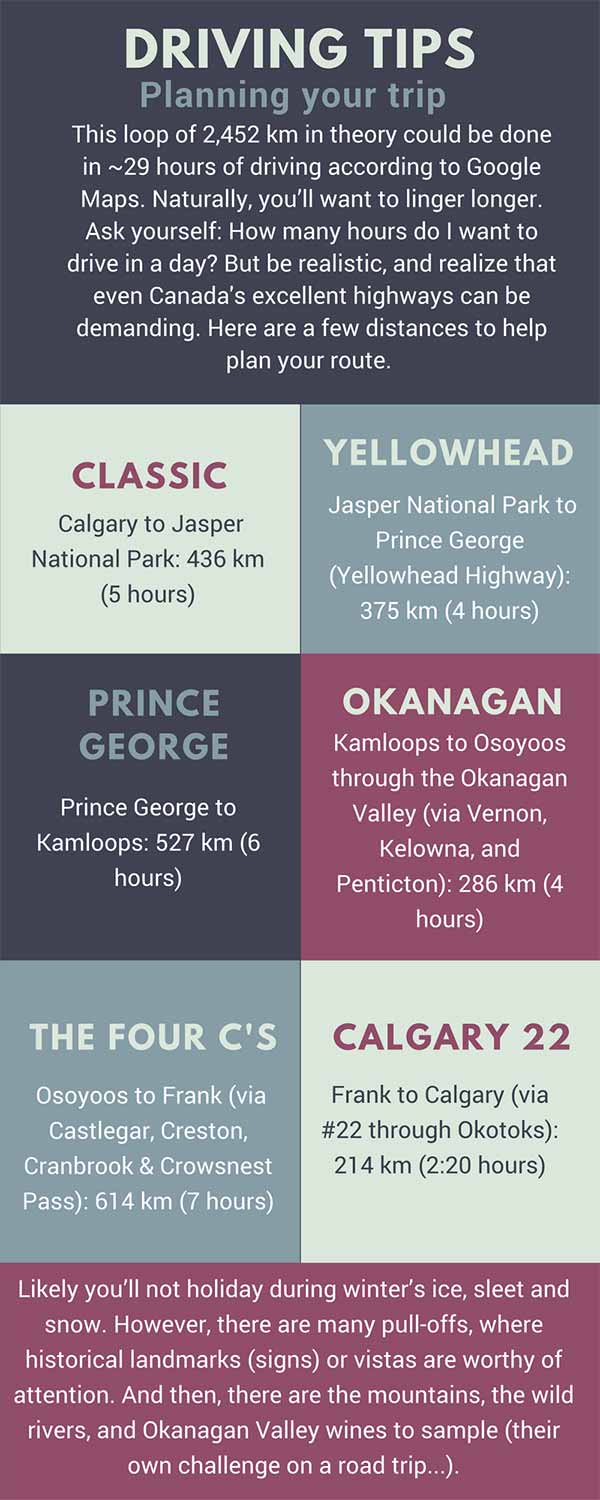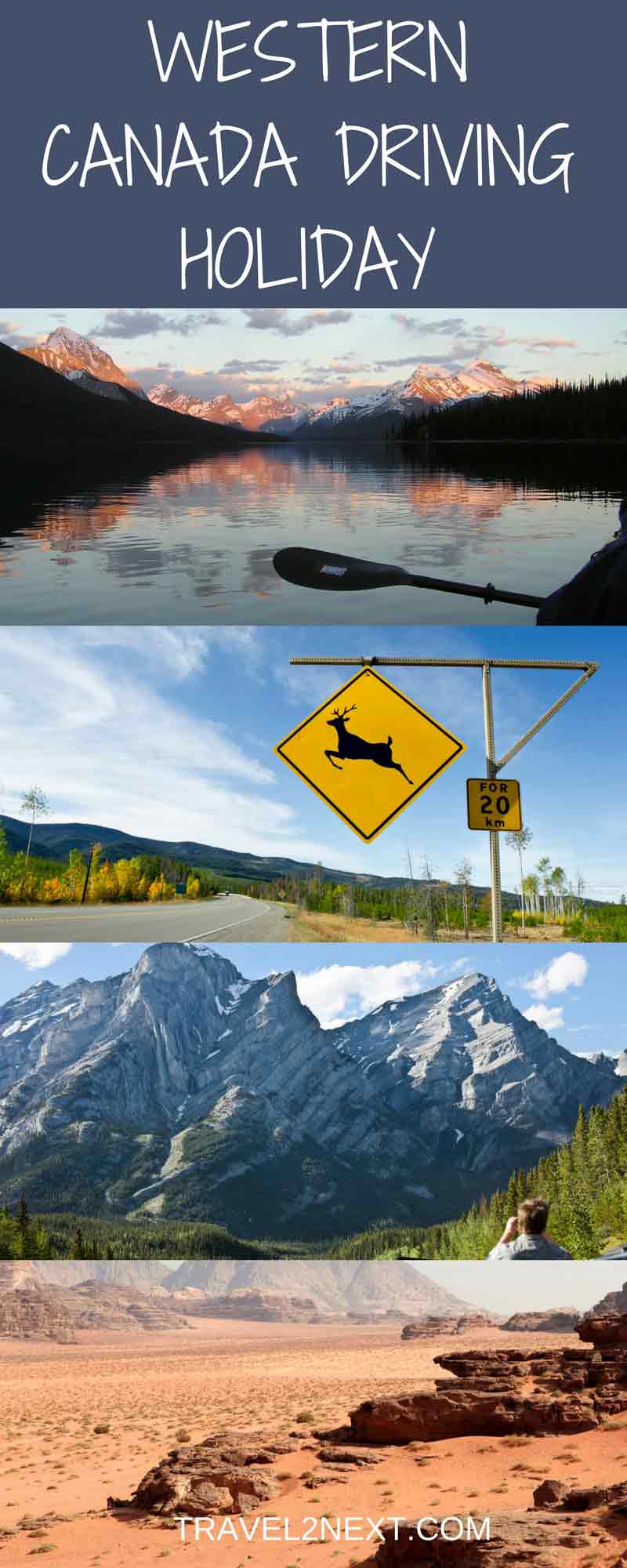The Milky Way courses through the sky like a fairy banner. Constellations such as Ursa Major and Cassiopeia twinkle above, connecting me to ancient peoples who wondered about the night sky long ago, just like us. Suddenly, the silence is split by a wolf’s howl. It echoes down my spine, unforgettably connecting me to the wild. Such magical moments have irrevocably altered my world view and my appreciation of wilderness and nature. While on the road in Western Canada, visiting Canada’s two westernmost provinces of British Columbia (BC) and Alberta, you will witness many similarly spellbinding moments.
 Driving Western Canada – Planning ahead for a circuit route
Driving Western Canada – Planning ahead for a circuit route
Canada is big, so planning a circuit road trip can be tricky. Expect many days of driving to experience bucket list destinations such as Banff and Jasper National Park and British Columbia’s Interior without rushing. However, fairly extensive circuits are both doable and fun on a western Canada driving holiday.
What makes driving particularly enjoyable are the many campgrounds and RV parks with shower blocks and facilities, particularly in national parks. And if you’re after something a little more luxurious, western Canada offers a variety of lodgings.
Drivers from Australia should remember that vehicles in Canada drive on the right-hand side of the road. Therefore, give yourself time to adjust, especially after a long flight when you might be feeling the effects of jet lag.
During Canada’s sesquicentennial (150th) birthday year of 2017, Parks Canada is offering free entry to the parks (fees for campsites and other costs remain).
Best practice with wildlife
No one can be cautious enough about wildlife encounters on the road or trail. Although it’s absolutely thrilling to see sheep, elk, grizzly or black bears and other critters on or beside the road, always be safety conscious and alert. And have cameras and binoculars ready.
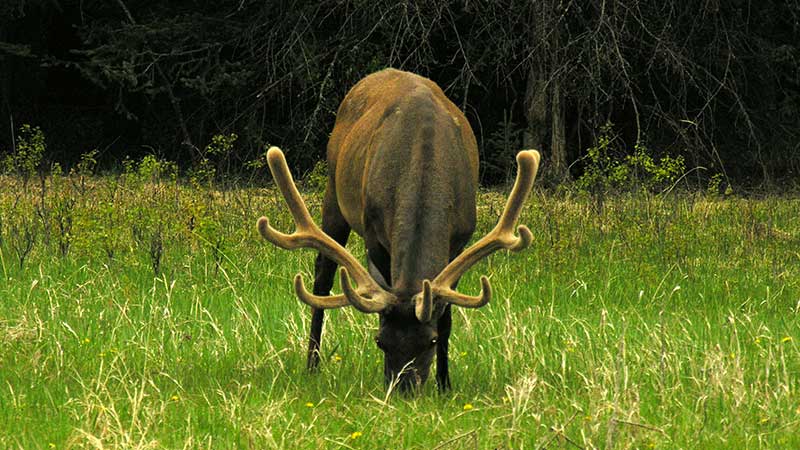
Check Parks Canada’s site for information regarding wildlife watching and understand you may be fined for feeding or worrying wild animals.
If you plan to hike or cycle, talk to Visitors’ Centre staff about bear warnings.
Some trails may be closed; others may remain open where signs warn users to stay in groups.
At RV and camping grounds, be wise: don’t store food in your tents and never, ever feed or touch wildlife.
There are plenty of amazing places to visit in western Canada on this Alberta and British Columbia driving adventure.
Fly to Calgary, rent an RV or car, then drive west into the mountains. The best thing about driving in western Canada is your destinations are totally up to you. There are so many spectacularly beautiful places to choose from but if it’s your first time in Canada, don’t miss Banff National Park, the Icefields Parkway and Jasper National Park.
Then continue driving west and south through British Columbia’s interior and the Okanagan Valley, east through the southern mountain cordillera and north again into Calgary.
Alberta’s Mountain country
I’d wager no one can approach the Rocky Mountain’s foothills after leaving Calgary’s urban scene and not be awed by the vast sea of ridges and peaks. The landscape is a panoramic vision on the horizon that will take your breath away.
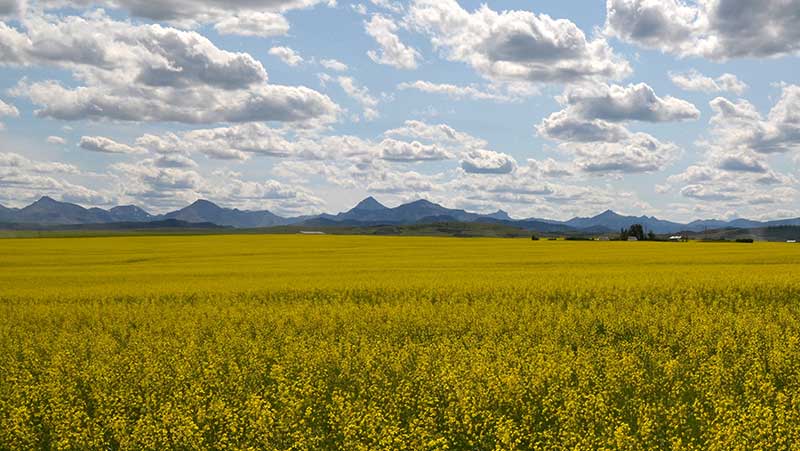
And when amid these towering peaks, I bet you’ll be pulling over frequently to take photos.
Here are some places to visit for awe-inspiring views and exciting things to do:
Banff National Park
Although Canada’s first national park opened in 1895, visitors still flock to experience its views and breathe the mountain air before continuing north to Lake Louise and Jasper National Park via the Icefields Parkway.
Banff village is very touristy – yet depending on your luck, surprisingly unpopulated strolls await. For example, The Bow River Trail courses through town and sometimes I’ve only seen a handful of people strolling or biking there.
To help identify the wildlife, visit Banff Park Museum National Historic Site of Canada, where there’s a magnificent taxidermy collection of critters.
Want to indulge your inner cowboy? Check out the one-to-multi-day horseback expeditions with Banff Trail Riders.
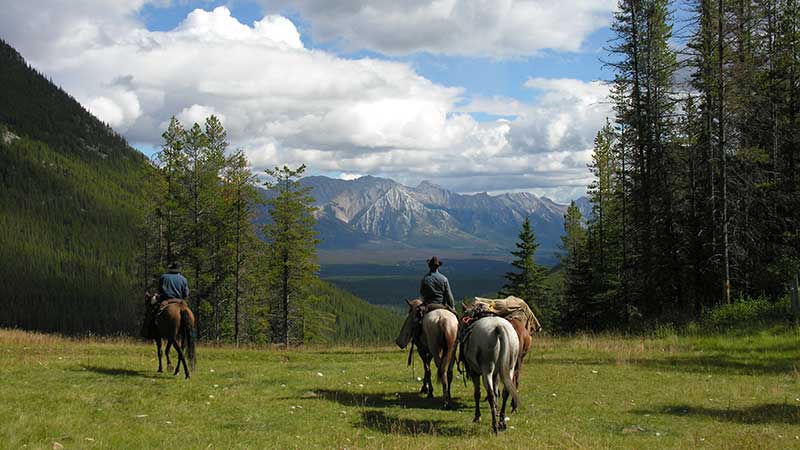
Interested in Rocky Mountain history and art? Don’t miss Whyte Museum and Archives, which turns 50 next year.
This former home of artists Catharine and Peter Whyte is a quintessentially Canadian log cabin packed with mountain art and artifacts.
Visit or stay at Fairmont Banff Springs, one of Canada’s renowned landmarks. The former Canadian Pacific Railway hotel is also known as the Castle of the Rockies.
Later, check out Fairmont Lake Louise and Fairmont Jasper Park Lodge: this famous triptych command remarkable views and claim fascinating stories of celebrities… and ghosts.
Tips: Parks Canada’s Banff website is a good resource for historic destinations worth visiting as well as glorious hiking and biking trails. For instance, the Canadian Rockies Hot Springs is a great spot to ease tired driving muscles.
Also, Friends of Banff National Park has helpful advice, maps, information on the park and free guided tours such as a birding walk at Vermillion Lakes.
Lake Louise
Next find Lake Louise, where you’ll understand why groups of visitors come here by the busloads to view this turquoise lake protected by a crescent of sheltering mountains.
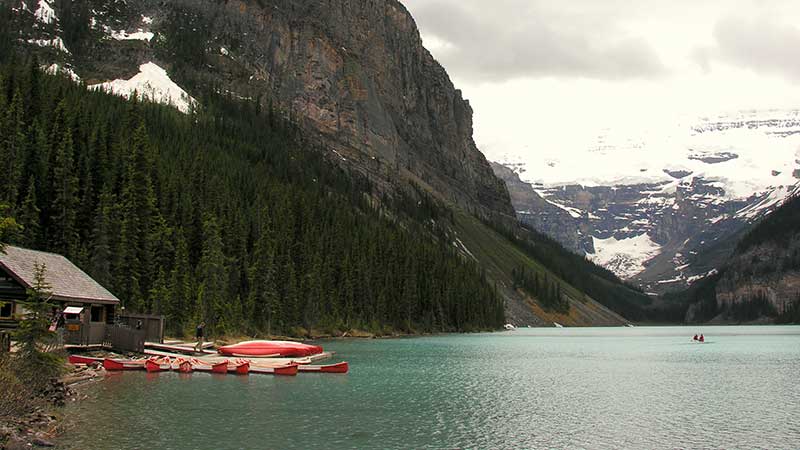
Rent a canoe and paddle the lake or hike 7km to the Lake Agnes Teahouse, named after the wife of Sir John A. Macdonald, Canada’s first Prime Minister, who visited the brand new park in 1886.
Icefields Parkway
Continuing north, enter the Columbia Icefields Parkway, a 232km stretch of road terminating at Jasper National Park. Plan a day to revel in a landscape of more than 100 glaciers, waterfalls and scenic viewpoints.
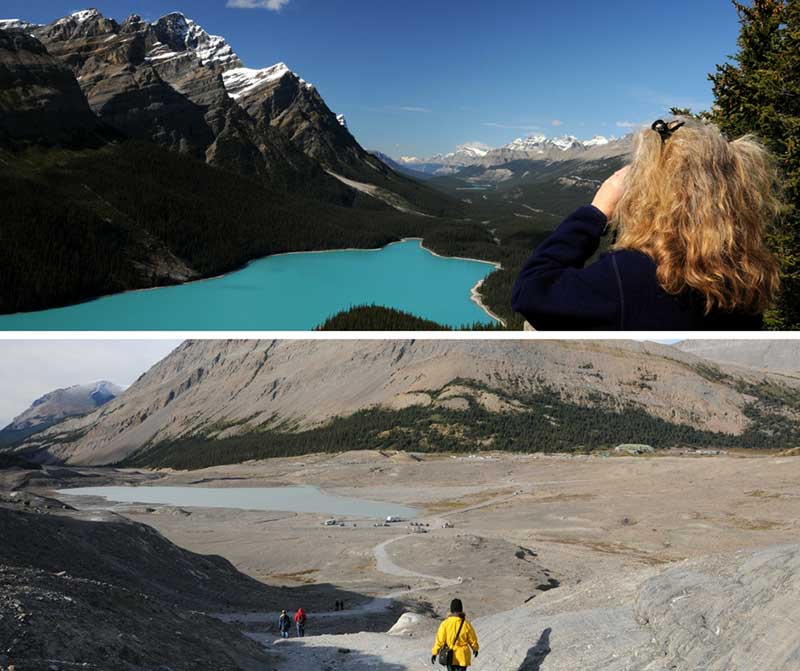
See Num-Ti-Jah Lodge, former home of legendary guide Jimmy Simpson. He built his cabin overlooking Bow Lake and Glacier in the early 1900s and when you see the view you won’t be surprised. What serenity he surely discovered here.
Back on the Icefields Parkway, visit Athabasca Glacier across from the Icefields Centre, where you can park.
A trail lets you walk amid the glacier’s terminal moraine to a viewing spot where it’s daunting to realize the flowing ice has receded some 1.5km from the highway due to climate change. At the Columbia Icefields Centre, join a tour on the icefield.
Jasper National Park
With more than 11,000 square kilometres, Jasper National Park is a vast expanse of wild backcountry as well as highly accessible hikes and viewpoints along the highway – plus good RV and camping facilities.
Jasper Village is inside the Park, a fascinatingly low-key counterpoint to Banff.
The architecturally picturesque Park Visitors’ Centre fashioned from timber and rocks is the place to visit for maps, books, and current information on what to do and how to do it.
Because much of its vastness is removed from ambient light, Jasper National Park is one of 17 Dark Sky Preserves in Canada, and the second-largest in the country.
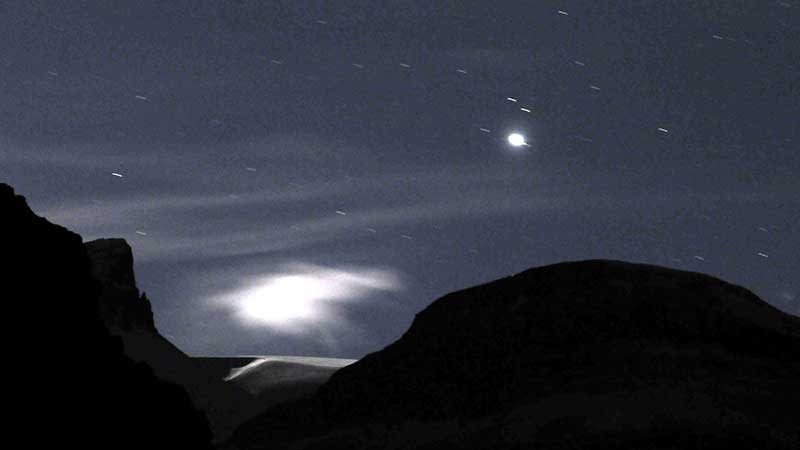
What’s unique about Jasper is the Dark Sky Festival, held annually in October.
The popular event brings members of the Royal Canadian Astronomical Society through to amateur astronomers – and people like me who simply love the night sky – together to celebrate stars, constellations, moons, galaxies and more.
Into British Columbia: Mountains and wine
Travelling northwest of Jasper, you’ll drive the Trans-Canada northwest to Prince George, then south through the forests and rangeland of the Cariboo-Chilcotin region before sweeping down into Kamloops, then into the orchards and vineyards of the Okanagan Valley.
South of Prince George, visit Quesnel (silent “s”) where the Quesnel and District Museum houses the largest collection of Chinese artifacts in North America.
Chinese immigrants helped build the first Canadian National Railroad and participated in Gold Rush days, and in so doing, became members of our Canadian multicultural family.
In the rangelands around 100 Mile House, investigate Guest Ranch stays: some are working ranches where guests do chores.
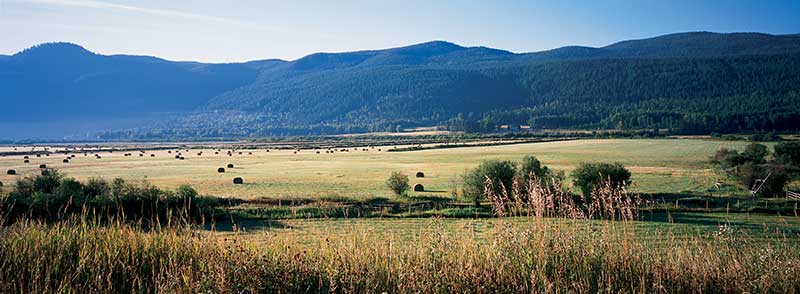
Why not really experience cowboy life as you pass through en route to Kamloops‘ lake and canyon country?
Okanagan Valley
After Kamloops, drive southeast towards Vernon, then south through the pretty towns of Kelowna, Peachland, Penticton, destination Osoyoos (immediately north of the US border and Washington state).
This route introduces you to the Okanagan Valley, with its multitude of fruit trees (cherry, apricot, peach, apple and more) and vineyards.
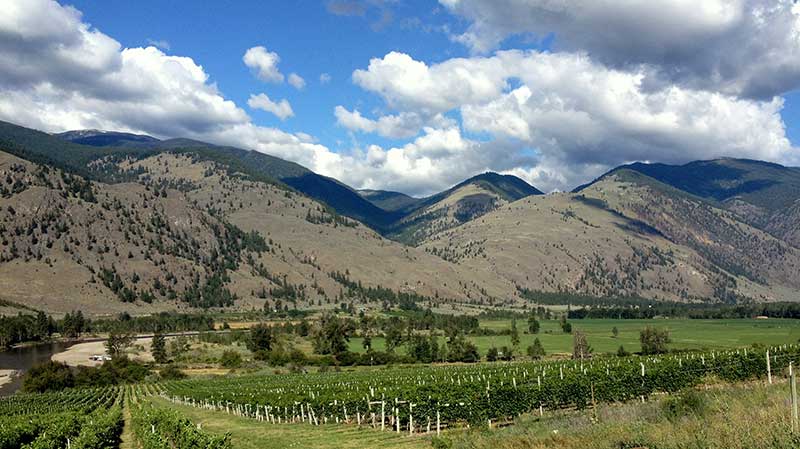
Dry cliffs and the fringes of lodgepole pine on hillsides give way to views of ultramarine blue lakes. Pause to camp, swim or windsurf, purchase fresh fruits and veggies – and do winery tours (where a guided driving tour just might be prudent…).
Eastward bound Kootenays to Alberta
Osoyoos marks the beginning of the 828 km return trip east culminating in Calgary.
The Visitors’ Centre is graced with a metal sculpture of a rearing horse with its First Nations rider dramatically thrusting his lance skyward.
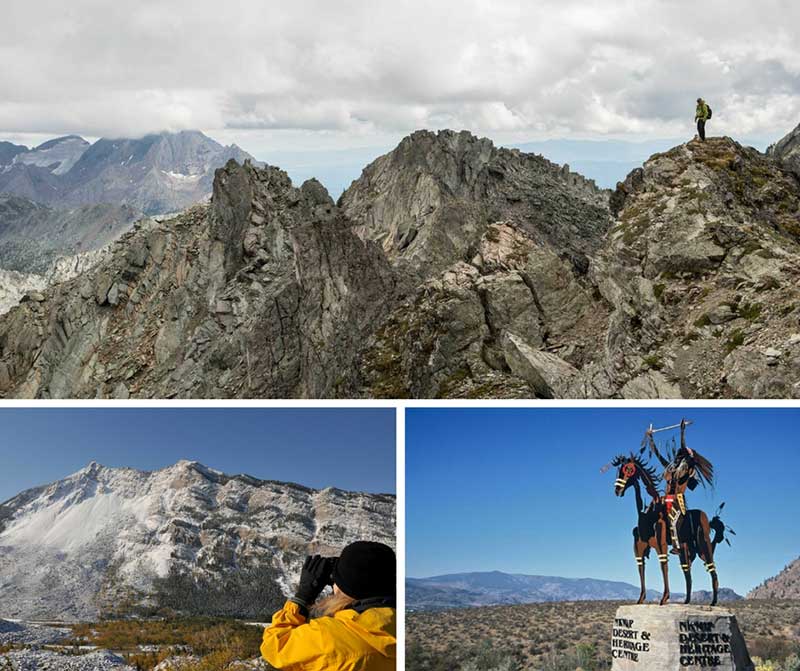
Enter for excellent maps, lodging and sightseeing information for your onward journey. You’ll now drive towards Castlegar in the Kootenays, a gorgeous landscape of green valleys, broad rivers (the Kootenay and Columbia), and increasingly grand mountains. Before long you’ll be crossing the Rocky Mountain cordillera into Alberta.
Truly, the Kootenays are legendary if not “epic” because of their powder snow for skiing in winter – and fantastic hikes, paddling, whitewater rafting and more, come summer.
Take care driving not just for the wildlife but because of the distracting “wow” factor of the scenery that you’ll see right through your journey. Slow and steady wins the day.
Castlegar’s intriguing history includes an influx of Russian immigrants called Doukhobors, in the early 1900s. Their culture is celebrated at the Doukhobor Discovery Centre. From here, drive to Creston, then to Cranbrook in the Rocky Mountain Trench.
Then slip into Alberta through the Crowsnest Pass to Frank, the site of Canada’s most deadly rockslide. The Frank Slide Interpretive Centre is truly something to witness. Two videos recreate the experience at the Centre’s theatre, and it’s sobering to understand how this coal mining town was obliterated when the face of Turtle Mountain tore away in 1903.
From Frank, watch for Highway 22 north – the Cowboy Highway.
The Cowboy Highway: Frank to Calgary
There’s still tons of dramatic landscape to appreciate after descending into Alberta’s foothills. The Cowboy Highway introduces us to glorious rangeland, wheat fields and skies that seem to last forever.
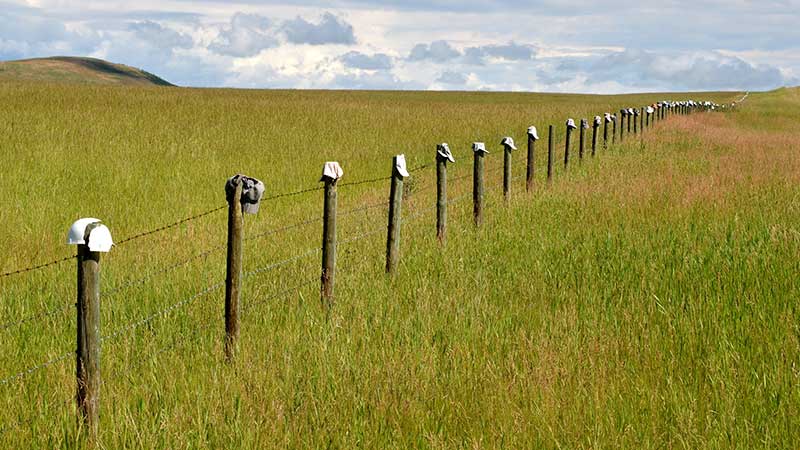
As you drive north your final 224km to Calgary, stop into the 1882 Bar U Ranch National Historic Site, which celebrates ranching history in Canada.
Take a horse-drawn wagon tour; hear a cowboy poet recite “cowboy poetry” born from a lonely life on the saddle; learn how this ranch was once the Percheron draft horse-breeding centre of the world.
The drive north deflects east once more via Highway 7 at Black Diamond, then from Okotoks, heads north to Calgary. Your circuit complete, now you’ll have hundreds of images to remind you of your amazing road trip.
Discover Western Canada
If you’re wondering where to stay while in the Rocky Mountains, consider staying at one of these two amazing wilderness lodges.
Plan Your Trip

Rent A Car – Find the best car rental rates at Discover Cars. They compare car hire companies to provide you with the best deal right now.

Find A Hotel – If you’re curious about this article and are looking for somewhere to stay, take a look at these amazing hotels.
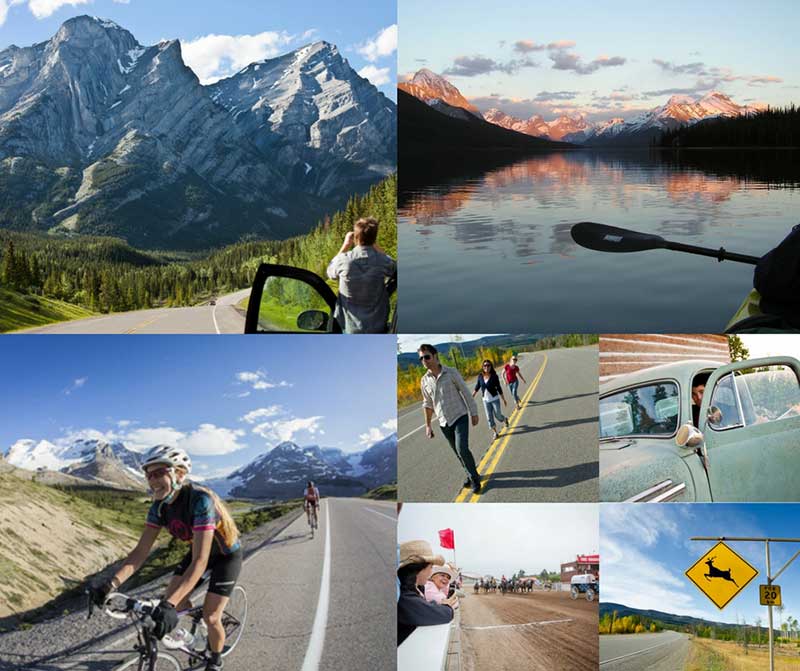 Driving Western Canada – Planning ahead for a circuit route
Driving Western Canada – Planning ahead for a circuit route